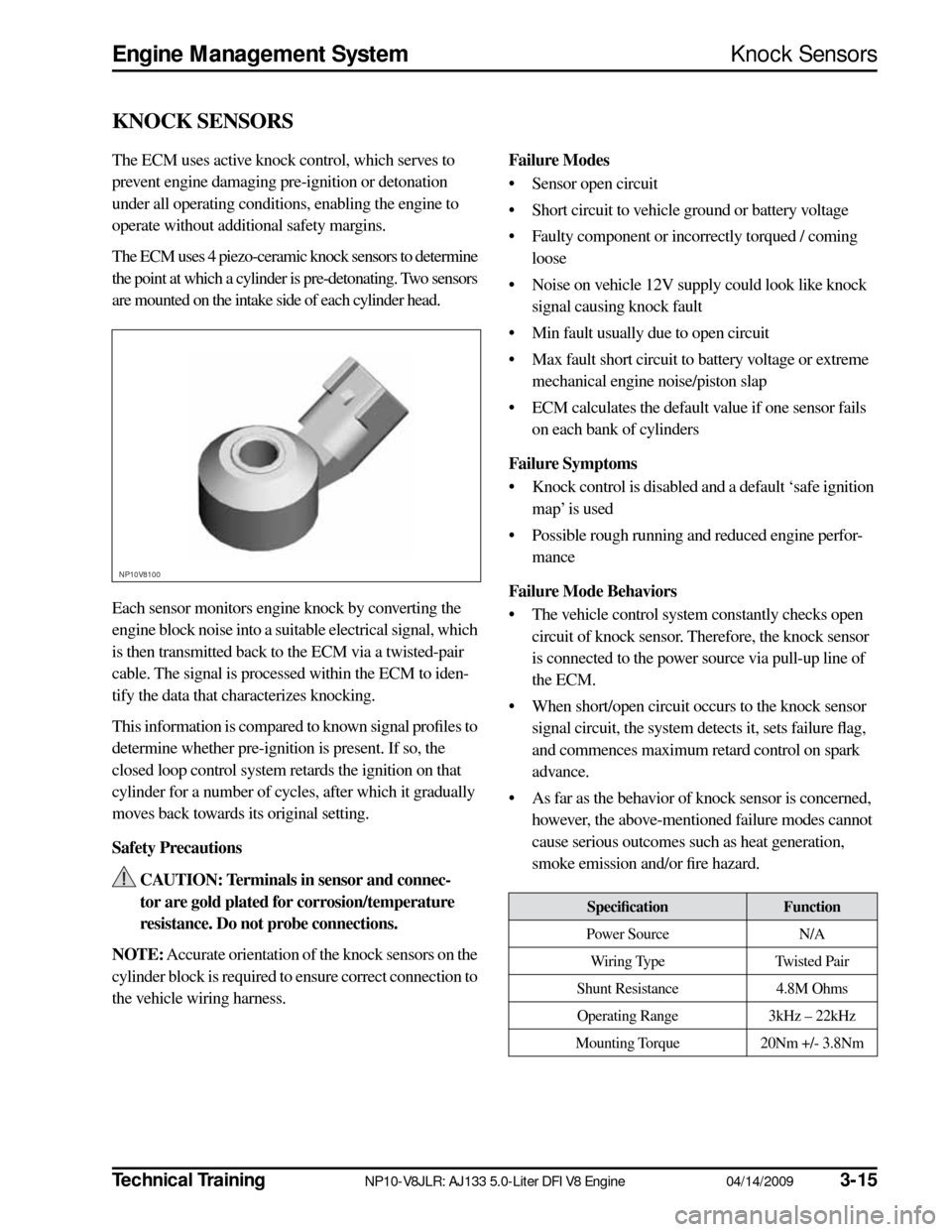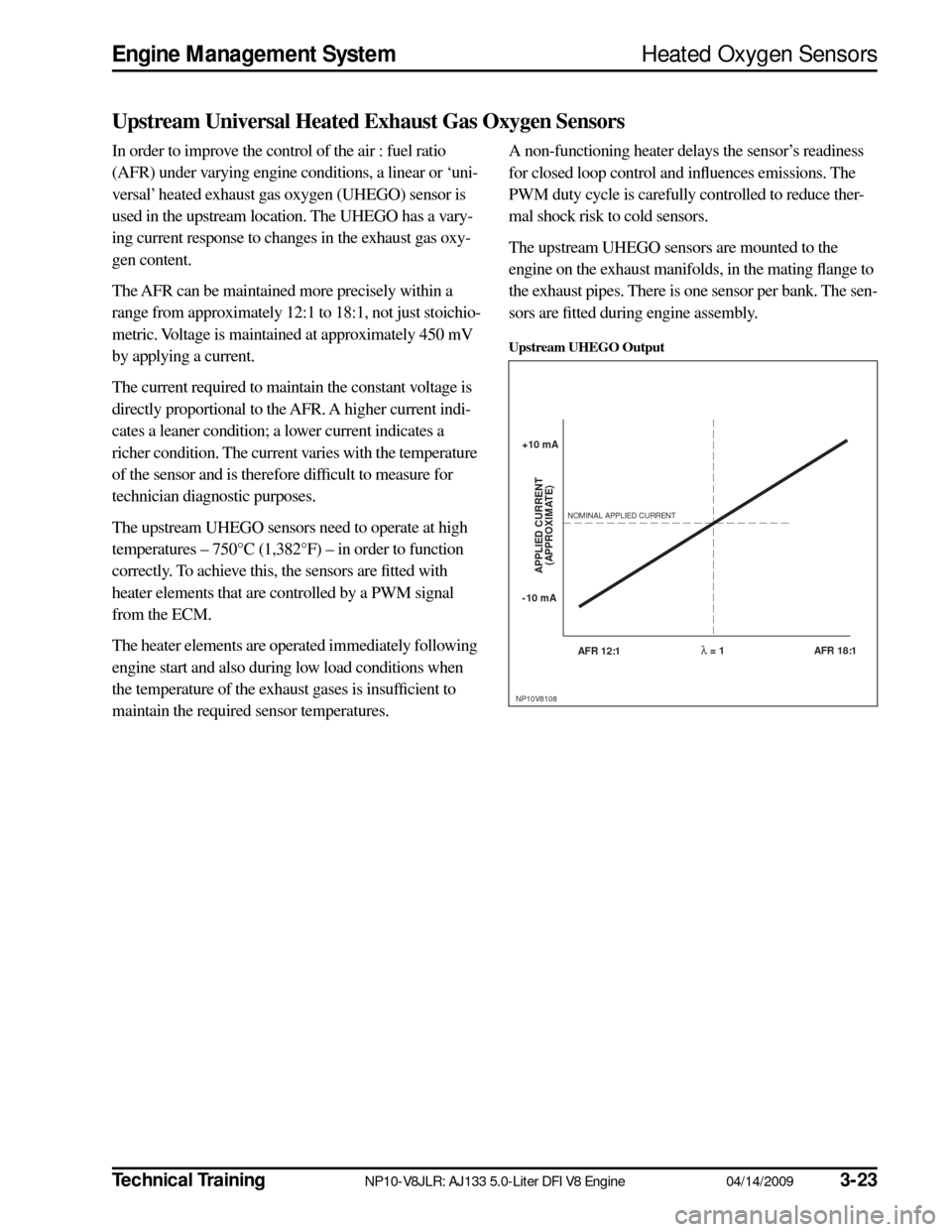air condition JAGUAR XF 2009 1.G AJ133 5.0L Engine Manual
[x] Cancel search | Manufacturer: JAGUAR, Model Year: 2009, Model line: XF, Model: JAGUAR XF 2009 1.GPages: 36, PDF Size: 0.38 MB
Page 17 of 36

Technical Training
NP10-V8JLR: AJ133 5.0-Liter DFI V8 Engine 04/14/2009
3-15
Engine Management System
Knock Sensors
KNOCK SENSORS
The ECM uses active knock control, which serves to
prevent engine damaging pre-ignition or detonation
under all operating conditions, enabling the engine to
operate without additional safety margins.
The ECM uses 4 piezo-ceramic knock sensors to determine
the point at which a cylinder is pre-detonating. Two sensors
are mounted on the intake side of each cylinder head.
Each sensor monitors engine knock by converting the
engine block noise into a suitable electrical signal, which
is then transmitted back to the ECM via a twisted-pair
cable. The signal is processed within the ECM to iden-
tify the data that characterizes knocking.
This information is compared to known signal profiles to
determine whether pre-ignition is present. If so, the
closed loop control system retards the ignition on that
cylinder for a number of cycles, after which it gradually
moves back towards its original setting.
Safety Precautions CAUTION: Terminals in sensor and connec-
tor are gold plated for corrosion/temperature
resistance. Do not probe connections.
NOTE:
Accurate orientation of the knock sensors on the
cylinder block is required to ensure correct connection to
the vehicle wiring harness.
Failure Modes
• Sensor open circuit
• Short circuit to vehicle ground or battery voltage
• Faulty component or incorrectly torqued / coming loose
• Noise on vehicle 12V supply could look like knock signal causing knock fault
• Min fault usually due to open circuit
• Max fault short circuit to battery voltage or extreme mechanical engine noise/piston slap
• ECM calculates the default value if one sensor fails on each bank of cylinders
Failure Symptoms
• Knock control is disabled and a default ‘safe ignition map’ is used
• Possible rough running and reduced engine perfor- mance
Failure Mode Behaviors
• The vehicle control system constantly checks open circuit of knock sensor. Therefore, the knock sensor
is connected to the power source via pull-up line of
the ECM.
• When short/open circuit occurs to the knock sensor signal circuit, the system detects it, sets failure flag,
and commences maximum retard control on spark
advance.
• As far as the behavior of knock sensor is concerned, however, the above-mentioned failure modes cannot
cause serious outcomes such as heat generation,
smoke emission and/or fire hazard.
NP10V8100
Specification
Function
Power Source N/A
Wiring Type Twisted Pair
Shunt Resistance 4.8M Ohms
Operating Range 3kHz – 22kHz
Mounting Torque 20Nm +/- 3.8Nm
Page 25 of 36

Technical TrainingNP10-V8JLR: AJ133 5.0-Liter DFI V8 Engine04/14/20093-23
Engine Management SystemHeated Oxygen Sensors
Upstream Universal Heated Exhaust Gas Oxygen Sensors
In order to improve the control of the air : fuel ratio
(AFR) under varying engine conditions, a linear or ‘uni-
versal’ heated exhaust gas oxygen (UHEGO) sensor is
used in the upstream location. The UHEGO has a vary-
ing current response to changes in the exhaust gas oxy-
gen content.
The AFR can be maintained more precisely within a
range from approximately 12:1 to 18:1, not just stoichio-
metric. Voltage is maintained at approximately 450 mV
by applying a current.
The current required to maintain the constant voltage is
directly proportional to the AFR. A higher current indi-
cates a leaner condition; a lower current indicates a
richer condition. The current varies with the temperature
of the sensor and is therefore difficult to measure for
technician diagnostic purposes.
The upstream UHEGO sensors need to operate at high
temperatures – 750°C (1,382°F) – in order to function
correctly. To achieve this, the sensors are fitted with
heater elements that are controlled by a PWM signal
from the ECM.
The heater elements are operated immediately following
engine start and also during low load conditions when
the temperature of the exhaust gases is insufficient to
maintain the required sensor temperatures.A non-functioning heater delays the sensor’s readiness
for closed loop control and influences emissions. The
PWM duty cycle is carefully controlled to reduce ther-
mal shock risk to cold sensors.
The upstream UHEGO sensors are mounted to the
engine on the exhaust manifolds, in the mating flange to
the exhaust pipes. There is one sensor per bank. The sen-
sors are fitted during engine assembly.
Upstream UHEGO Output
NP10V8108
+10 mA
NOMINAL APPLIED CURRENT
-10 mA
AFR 12:1
APPLIED CURRENT(APPROXIMATE)
AFR 18:1λ = 1
Page 27 of 36

Technical TrainingNP10-V8JLR: AJ133 5.0-Liter DFI V8 Engine04/14/20093-25
Engine Management SystemHeated Oxygen Sensors
Safety Precautions
WARNINGS:
• Anti-seize compound used on service sensor threads may be a health hazard. Avoid skin
contact.
• Exhaust system components, catalysts in particular, operate at high temperatures and
remain hot for a long time after operation.
CAUTIONS:
• Oxygen sensors must be treated with the utmost care before and during the fitting
process. The sensors have ceramic material
within them that can easily crack if
dropped or over-torqued. They must be
tightened to the specified torque figure with
a calibrated torque wrench. Care should be
taken not to contaminate the sensor tip
when the anti-seize compound is used on
the thread.
• To prevent damage to the sensors, a special tool (box spanner) should be used when
removing.
• If the sensor sticks in the exhaust, apply de- seize product and use a repeating tighten
and loosen strategy.
• Ensure that the sensor harness is robustly secured away from moving or hot parts. Failure Modes
• Mechanical fitting and integrity of the sensor (i.e.
cracked)
• Sensor open circuit/disconnected
• Short circuit to battery voltage or ground.
• Lambda ratio outside operating band
• Crossed sensors (RH bank fitted to LH bank and vice-versa)
• Contamination from leaded fuel or other sources
• Harness damage
• Air leak into exhaust system (cracked pipe/weld or loose fixings)
Failure Symptoms
• Default to open loop fuel metering
• High CO reading
• Strong smell of sulfur (rotten eggs) until default condition
• Excess emissions
• Unstable operation
• Reduced performance
Page 33 of 36

Technical TrainingNP10-V8JLR: AJ133 5.0-Liter DFI V8 Engine04/14/20093-31
Engine Management SystemOn-Board Diagnostic Monitoring
ON-BOARD DIAGNOSTIC MONITORING
Some OBD monitors are continuous, that is they operate
all the time the ignition is on.
Some OBD monitors have conditions that must be met
before the monitor is allowed to operate, such as engine
speed 1000 – 4000 rpm and engine airflow 10 – 100 g/
sec and intake air temperature -10 – +50°C, in order to
ensure the vehicle is operating in such a manner that the
failure may be correctly diagnosed. For this reason it
may be possible for a failure to be present on the vehicle
but remain undetected by the module.
Most OBD monitors use 2-trip detection: if on the first
occasion the failure is detected, a pending DTC is
recorded. If the failure is again detected on the next drive
cycle, then a confirmed DTC is logged and the MIL may
be illuminated.
A few OBD monitors operate on a single-trip basis
where the MIL is illuminated as soon as the failure is
diagnosed.
Detection of a failure may prevent the operation of other
OBD monitors. This is to prevent the logging of multiple
DTCs for a single. However, the system is not infallible,
and a single fault may result in two or more failures
being detected, with two or more DTCs being recorded.